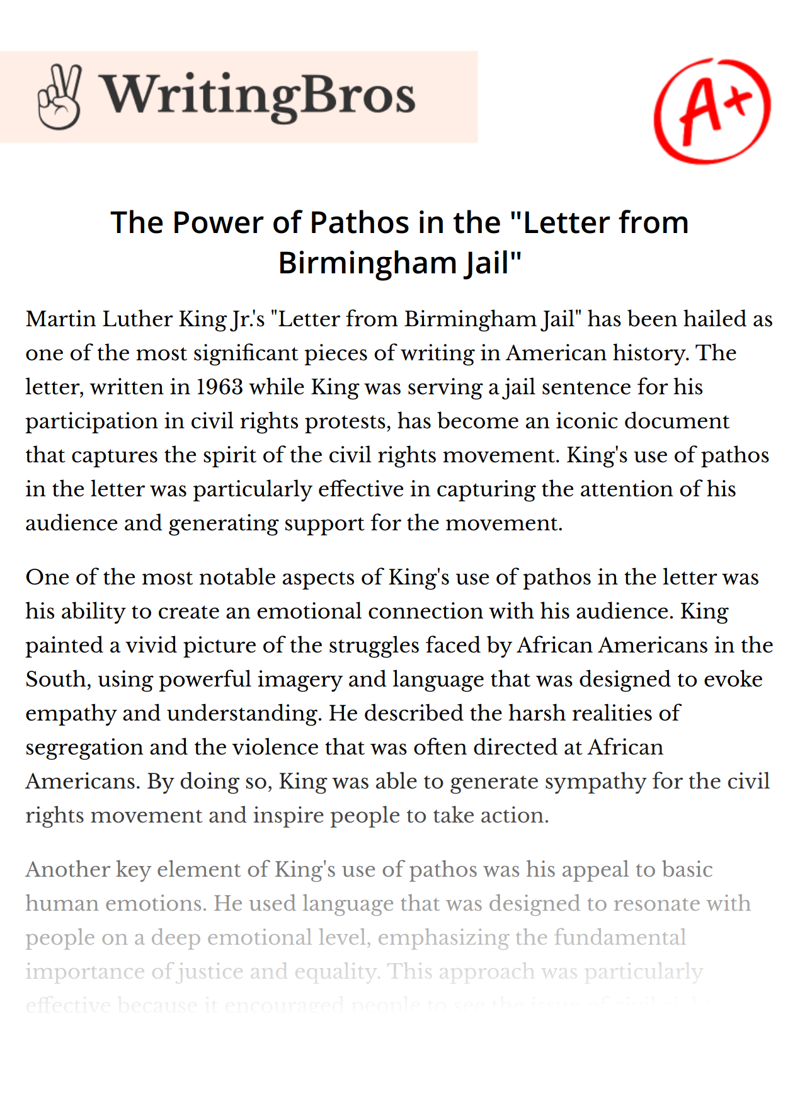The Power of Pathos in the "Letter from Birmingham Jail"

Martin Luther King Jr.'s "Letter from Birmingham Jail" has been hailed as one of the most significant pieces of writing in American history. The letter, written in 1963 while King was serving a jail sentence for his participation in civil rights protests, has become an iconic document that captures the spirit of the civil rights movement. King's use of pathos in the letter was particularly effective in capturing the attention of his audience and generating support for the movement.
One of the most notable aspects of King's use of pathos in the letter was his ability to create an emotional connection with his audience. King painted a vivid picture of the struggles faced by African Americans in the South, using powerful imagery and language that was designed to evoke empathy and understanding. He described the harsh realities of segregation and the violence that was often directed at African Americans. By doing so, King was able to generate sympathy for the civil rights movement and inspire people to take action.
Another key element of King's use of pathos was his appeal to basic human emotions. He used language that was designed to resonate with people on a deep emotional level, emphasizing the fundamental importance of justice and equality. This approach was particularly effective because it encouraged people to see the issue of civil rights as something that was not only morally right but also essential to the well-being of society as a whole.
King's use of pathos was also effective in building support for the civil rights movement among people who may not have been directly affected by segregation or discrimination. He made a compelling case for why the issue of civil rights was not just a problem for African Americans but for all Americans. By emphasizing the fundamental importance of justice and equality, King was able to appeal to people's sense of fairness and encourage them to support the cause of civil rights.
In addition to his use of pathos, King also made a compelling case for civil rights using logic and reason. He presented a logical argument for why segregation and discrimination were unjust and morally wrong, using historical examples and legal precedents to support his case. This approach was particularly effective in convincing people who may have been skeptical of the civil rights movement or who may have been on the fence about supporting it.
King's use of pathos in his letter was also instrumental in bringing attention to the civil rights movement. The letter was widely circulated and published in newspapers across the country, drawing attention to the struggles faced by African Americans in the South. The emotional appeal of the letter helped to build public support for the movement, putting pressure on those in power to enact change.
In conclusion, Martin Luther King Jr.'s use of pathos in his "Letter from Birmingham Jail" was instrumental in generating support for the civil rights movement. Through his use of powerful imagery, emotional language, and appeals to basic human emotions, King was able to create an emotional connection with his audience and inspire them to take action. His letter remains an important document in American history and a reminder of the importance of fighting for justice and equality for all people.
Cite this Essay
To export a reference to this article please select a referencing style below

